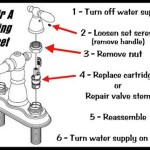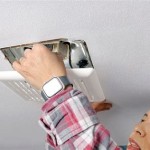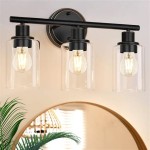Plumbing A Bathroom Sink Drain: A Comprehensive Guide
Plumbing a bathroom sink drain, while seemingly straightforward, requires a systematic approach and a clear understanding of the components involved. The drain assembly connects the sink basin to the main drain line in the wall, facilitating the outflow of water and waste. Proper installation and maintenance of this system are crucial for preventing leaks, clogs, and other plumbing issues. This article will provide a detailed guide to plumbing a bathroom sink drain, covering the necessary tools, materials, and procedures.
Prior to initiating any plumbing work, safety precautions must be observed. The water supply to the sink should be shut off at the shut-off valves located under the sink. If shut-off valves are not present or are malfunctioning, the main water supply to the house must be turned off. This step prevents accidental flooding and water damage during the installation process. Additionally, wearing safety glasses is recommended to protect the eyes from debris.
Before beginning the sink drain installation, gather all the necessary tools and materials. The absence of a required tool mid-project can lead to delays and potential complications. A list of essential items includes: a basin wrench, a pipe wrench, channel-lock pliers, plumber's putty, Teflon tape, a hacksaw (or pipe cutter), a measuring tape, a bucket, rags or towels, and the new drain assembly kit. The drain assembly kit typically includes the tailpiece, P-trap, drain flange, drain stopper, and necessary washers and nuts. Ensuring the kit is complete and compatible with the sink and drain line is crucial.
Identifying the Components of a Sink Drain
Understanding the function of each component is paramount for a successful plumbing installation. The drain flange is the uppermost part of the assembly, fitting into the sink's drain opening. It provides a secure and watertight connection between the sink and the drain system. A rubber or putty seal is usually necessary to make this connection leak-proof.
The tailpiece is a vertical pipe that connects directly to the drain flange, extending downwards from the sink. It is typically made of PVC or metal and is either threaded or smooth, depending on the type of connection it makes with the subsequent components. The length of the tailpiece may need to be adjusted using a hacksaw or pipe cutter to ensure proper fit.
The P-trap is a U-shaped pipe that connects to the tailpiece. Its primary function is to trap water, creating a water seal that prevents sewer gases from entering the bathroom. This water seal also helps to catch small debris and prevent clogs from forming further down the drain line.
The drainpipe extends from the P-trap to the main drain line in the wall. This connection is often made using a threaded fitting or a compression fitting. The drainpipe must be properly aligned and securely connected to prevent leaks and ensure the proper flow of wastewater.
The drain stopper is a mechanism that allows the user to block the drain opening, enabling the sink to hold water. There are several types of drain stoppers, including pop-up stoppers, lift-and-turn stoppers, and push-button stoppers. Each type has a slightly different installation procedure, but the basic principles remain the same.
Removing the Old Sink Drain
The first step in removing the old sink drain is to place a bucket beneath the P-trap to catch any remaining water. Using channel-lock pliers or a pipe wrench, carefully loosen the slip nuts that connect the P-trap to the tailpiece and the drainpipe. If the nuts are corroded or stuck, penetrating oil can be applied to help loosen them. Avoid applying excessive force, as this can damage the pipes and fittings.
Once the P-trap is disconnected, carefully remove the tailpiece from the drain flange. The tailpiece may be connected to the drain flange with a slip nut or a threaded connection. Loosen the appropriate fitting and remove the tailpiece. Inspect the tailpiece for signs of damage or corrosion, and replace it if necessary.
The drain flange is typically held in place by a large nut underneath the sink. Use a basin wrench to loosen this nut. A basin wrench is specifically designed to reach tight spaces and provide leverage for loosening stubborn nuts. Once the nut is loose, carefully remove the drain flange from the sink opening. Clean the sink opening thoroughly with a rag to remove any old putty or debris.
Examine the removed components for signs of wear or damage. This can help identify the cause of any previous leaks or drainage issues. Replacing worn or damaged components during the new installation can help prevent future problems.
Installing the New Sink Drain
Begin by applying a bead of plumber's putty around the underside of the new drain flange. This putty will create a watertight seal between the drain flange and the sink basin. Ensure the putty is evenly distributed and covers the entire underside of the flange.
Insert the drain flange into the sink opening, pressing it firmly against the putty. From underneath the sink, install the rubber washer, cardboard washer, and mounting nut onto the drain flange. Tighten the mounting nut by hand until it is snug. Then, use a basin wrench to further tighten the nut, ensuring a secure and watertight connection. Avoid overtightening, as this can crack the sink basin.
Next, install the tailpiece onto the drain flange. Depending on the type of tailpiece, it may be connected with a slip nut or a threaded connection. If using a slip nut, slide the nut and a washer onto the tailpiece, then insert the tailpiece into the drain flange and tighten the nut by hand. If using a threaded connection, apply Teflon tape to the threads of the tailpiece before screwing it into the drain flange.
Assemble the P-trap and connect it to the tailpiece and the drainpipe. Ensure that the P-trap is properly aligned and that all slip nuts are tightened securely by hand. The P-trap should be positioned so that it holds water, creating a water seal to prevent sewer gases from entering the bathroom. It may be necessary to adjust the length of the tailpiece or the drainpipe to ensure a proper fit.
If the drainpipe connects to the main drain line with a threaded connection, apply Teflon tape to the threads before screwing the pipe into the fitting. If the drainpipe connects with a compression fitting, ensure that all components are properly aligned and tightened according to the manufacturer's instructions.
Install the drain stopper according to the manufacturer's instructions. The installation procedure will vary depending on the type of stopper. Ensure that the stopper functions properly and that it creates a watertight seal when closed.
Testing the New Drain
After completing the installation, it is crucial to test the new drain for leaks. Remove any tools or materials from the area and carefully turn on the water supply to the sink.
Fill the sink with water and observe the drain connections for any signs of leaks. Pay close attention to the drain flange, tailpiece, P-trap, and drainpipe connections. If any leaks are detected, immediately turn off the water supply and tighten the corresponding fittings. If the leaks persist, disassemble the connections and inspect the components for damage or misalignment. Reapply Teflon tape or plumber's putty as needed.
Once the drain connections are leak-free, allow the water to drain from the sink. Observe the flow of water and ensure that it drains smoothly and quickly. If the drain is slow or clogged, there may be an obstruction in the drainpipe. Use a plunger or drain snake to clear the obstruction.
Run the water for several minutes to ensure that all connections remain leak-free. Inspect the area under the sink regularly for the first few days after the installation to ensure that no leaks develop over time.
Proper disposal of old plumbing components and materials is essential. Dispose of old pipes, fittings, and plumber's putty according to local regulations. Recycle any recyclable materials whenever possible.
Regular maintenance can help prevent clogs and other plumbing issues. Periodically flush the drain with hot water to remove grease and debris. Avoid pouring harsh chemicals down the drain, as these can damage the pipes and fittings. Consider using a drain strainer to prevent hair and other debris from entering the drain.

How To Plumb A Bathroom With Multiple Plumbing Diagrams Hammerpedia

Bathroom Sink Plumbing
How To Install Bathroom Sink Drain Queen Bee Of Honey Dos

Bathroom Sink Drains Plumbing Replace

Plumbing Repairs How To Repair Fix It Diy Install Bathroom Sink

How To Connect A Bathroom Sink Drain

What Is The Bathroom Sink Plumbing Rough In Heights

How To Easily Connect The Plumbing For A New Bathroom Sink Hometips

How To Plumb A Drain Sink Pipes
What Plumbing Piece Is Normally Used To Transition From 1 4 Bathroom Sink 2 Drain Pipe Quora







